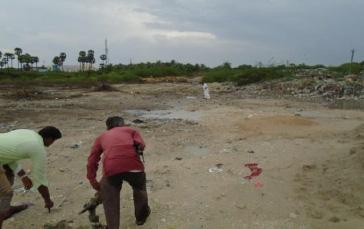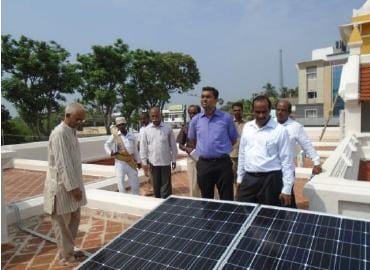November 2016
Newsletters

Rameshwaram, the anchor of Indian Renaissance – 9
Rameshwaram is a temple city and the temple of Ramanathaswami is at the centre of the life of the city. This arrangement was very unique and profound in ancient Indian culture and deserves some elaboration. Right from the architecture, sculpture and surroundings, temple had many unique aspects representing the essence of Indian culture and ethos.
Sri Aurobindo has elaborated in his book – ‘The Foundations of Indian Culture’ about Indian Architecture and Sculpture. In his words, Indian temple is an altar raised to the Divine Self. How to see a temple?


Waste Management
- Picking Litter Campaign conducted at Agni Threetham Sea-shore at Rameswaram on 12.11.2016. The campaign was inaugurated by District Collector Dr.Natrajan. Municipal Commissioner, Shri.Jayaram Raja also Participated.
- 585 students from SPA Girls Hr. Sec School, St Joseph Hr. Sec School and Govt. Boys Hr. Sec School participated in the campaign.


Nakshatra Vanam
A deciduous tree, tall and with a spreading, dense, round, shady canopy. The bark is rough, brown in colour, slightly cracked and fissured, the inner bark is red, exudes white and milky sap when cut. The leaves are elliptic, tip pointed, base angled, texture thick, hairy beneath, the nerves are strong, about 12 pairs, the tertiary nerves are oblique, and margin entire but may be wavy. The stalk is reddish. The flowers are available in bunches at the end of the branches. They are white, 2 cm long, pointed, sweet scented and fleshy. The fruits are ovoid, fleshy, 2- 4 cm across, greenish and 1- 4 seeded. The seeds elongate and are 2 cm long; brown and shining. The tree grows on a wide variety of soils but prefers sandy soil and alluvial soil.
The flowering season extends from February to April. There is heavy fall of succulent, corollas on the ground. It is rich in sugar (73%) and next to cane molasses constitute the most important raw material for alcohol fermentation. The yield of 95% alcohol is 405 liters from one tone of dried flowers. The matured fruits fall on the ground in May to July in north India and August and September in south India. The orange brown ripe fleshy berry is 2.5 to 5 cm long and contains one to four shining seeds. The seeds can be separated from the fruit wall by pressing. Drying and decortications yield 70% kernels on the weight of seeds.
Rameshwaram is a temple city and the temple of Ramanathaswami is at the centre of the life of the city. This arrangement was very unique and profound in ancient Indian culture and deserves some elaboration. Right from the architecture, sculpture and surroundings, temple had many unique aspects representing the essence of Indian culture and ethos.
Sri Aurobindo has elaborated in his book – ‘The Foundations of Indian Culture’ about Indian Architecture and Sculpture. In his words, Indian temple is an altar raised to the Divine Self. How to see a temple? He explains:
“To appreciate [the] spiritual-aesthetic truth of Indian architecture, it will be best to look first at some work where there is not the complication of surroundings now often out of harmony with the building. … The straightway here is not to detach the temple from its surroundings, but to see it in unity with the sky and low-lying landscape or with the sky and hills around and feel the thing common to both, the construction and its environment, the reality in Nature, the reality expressed in the work of art. The oneness to which this Nature aspires in her inconscient self-creation and in which she lives, the oneness to which the soul of man uplifts itself in his conscious spiritual upbuilding, his labor of aspiration here expressed in stone, and in which so upbuilt he and his work live, are the same and the soul-motive is one… There is in both a constant, subtle yet pronounced lessening from the base towards the top, but at each stage the repetition of the same form, the same multiplicity of insistence, the same crowded fullness and indented relief, but one maintains its multiple endeavor and indication to the last, the other ends in a single sign.
A deciduous tree, tall and with a spreading, dense, round, shady canopy. The bark is rough, brown in colour, slightly cracked and fissured, the inner bark is red, exudes white and milky sap when cut. The leaves are elliptic, tip pointed, base angled, texture thick, hairy beneath, the nerves are strong, about 12 pairs, the tertiary nerves are oblique, and margin entire but may be wavy. The stalk is reddish. The flowers are available in bunches at the end of the branches. They are white, 2 cm long, pointed, sweet scented and fleshy. The fruits are ovoid, fleshy, 2- 4 cm across, greenish and 1- 4 seeded. The seeds elongate and are 2 cm long; brown and shining. The tree grows on a wide variety of soils but prefers sandy soil and alluvial soil.
The flowering season extends from February to April. There is heavy fall of succulent, corollas on the ground. It is rich in sugar (73%) and next to cane molasses constitute the most important raw material for alcohol fermentation. The yield of 95% alcohol is 405 liters from one tone of dried flowers. The matured fruits fall on the ground in May to July in north India and August and September in south India. The orange brown ripe fleshy berry is 2.5 to 5 cm long and contains one to four shining seeds. The seeds can be separated from the fruit wall by pressing. Drying and decortications yield 70% kernels on the weight of seeds.


Renovation of Traditional Water Bodies (TWB) -Survey of Teerthams in the Island of Rameshwaram
Dist. Collector Dr.Natarajan was kind enough in deputing surveyors from Ramanathapuram exclusively for carrying out the long pending survey of Teerthams (water bodies). Out of the 42 Teerthams, survey for 17 water bodies was carried out on 17th, 18th and 21st November by the Govt. surveyors with the help of HR & CE and other staff members. Teerthams covered are given below


Social Capital
Dist. Collector Dr.Natarajan, IAS inspecting the solar installation at ‘Green Rameswaram’ building.


Energy Efficient Appliances
In the last blog, the advantages of replacing the existing single phase motors with PMSM (Permanent Magnet Synchronous Motors) was described. The techniques of energy efficient motor along with variable speed operation give rise to enormous energy savings in regular appliances like Room Air Conditioners, Refrigerators, Fans, Pumps, etc. The air conditioning load is the major energy guzzler mainly in the urban households. Compared to other appliances, the air con is both energy intensive and runs for long periods. This is true for homes, commercial establishments, offices (government & private) and industries. Apart from comfort cooling, the air con is used for cold storage applications also, when the room temperature is to be around 15 ~ 250 C. This kind of cold storage is needed in food processing industry and storage of special materials. In chemical industries, materials like Chemicals, resins, etc., have to be stored at specific temperatures to ensure long shelf life.

